Poole Ch.P., Jr. Handbook of Superconductivity
Подождите немного. Документ загружается.

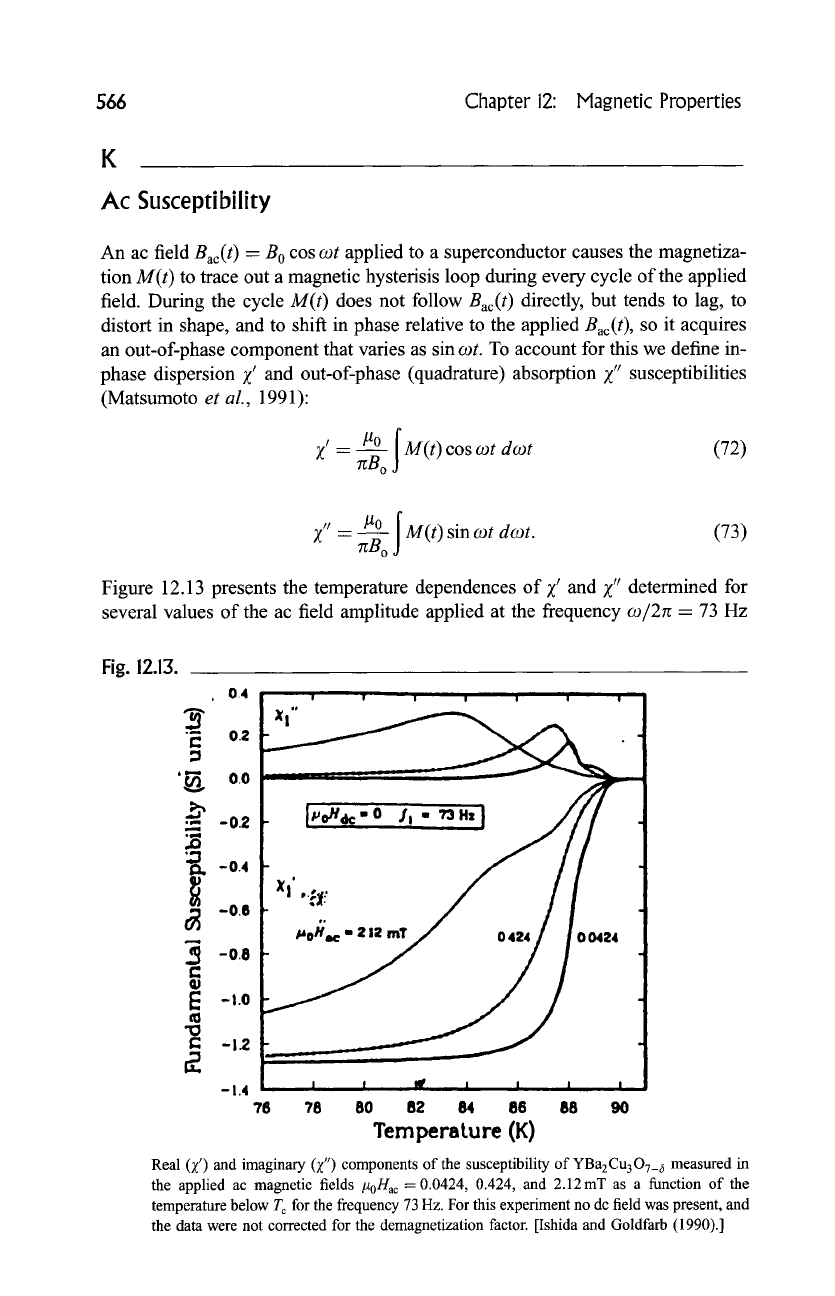
566
Chapter
12:
Magnetic Properties
K
Ac Susceptibility
An ac field Bac(t ) = B 0 cos cot applied to a superconductor causes the magnetiza-
tion
M(t)
to trace out a magnetic hysterisis loop during every cycle of the applied
field. During the cycle
M(t)
does not follow Bac(t ) directly, but tends to lag, to
distort in shape, and to shift in phase relative to the applied Bac(t ), so it acquires
an out-of-phase component that varies as sin cot. To account for this we define in-
phase dispersion g' and out-of-phase (quadrature) absorption Z" susceptibilities
(Matsumoto
et at,
1991):
7/-- ~o J M(t)
cos
cot dcot
(72)
;~" - la~ l M(t)
sin
cot dcot.
(73)
Figure 12.13 presents the temperature dependences of Z' and g" determined for
several values of the ac field amplitude applied at the frequency co/2rc - 73 Hz
Fig. 12.13.
, 0.4
"~
0.2
'~,~_~ 0.0
-0.2
~, -0.4
1~
-0.6
..~
-0.8
~ -I.0
~ -1.2
-1.4
XI"
.u, oHdc-O 11 " ?'JHz
xl'
,.~.
o,
#0Hac - 212
mT
0424
7e 're eo e2 e4 ee ee 90
Temperature
(K)
Real (Z') and imaginary (Z") components of the susceptibility of YBa2Cu3OT_6 measured in
the applied ac magnetic fields #0Hac = 0.0424, 0.424, and 2.12mT as a function of the
temperature below T c for the frequency 73 Hz. For this experiment no dc field was present, and
the data were not corrected for the demagnetization factor. [Ishida and Goldfarb (1990).]

References
$67
with no dc field present. A simultaneously applied dc field affects the temperature
dependence of Z' and Z"-
References
J. R. Chem,
Phys. Rev. B
43, 7837 (1991).
T. Ishida and R. B. Goldfarb,
Phys. Rev. B
41, 8937 (1990).
W. E. Lawrence and S. Doniach, in
Proc. 12th Int. Conf. Low Temp. Phys. Kyoto, 1970
(E. Kanda, Ed.),
p. 361. Keigaku, Tokyo, 1971.
Y. Matsumoto, M. Katada, and T. Nishida,
Physica C
185, 1229 (1991).
C. P. Poole, Jr., H. A. Farach, and R. J. Creswick,
Superconductivity.
Academic Press, New York, 1995;
vide Chapters 9-12.
S. Senoussi, M. Oussena, and S. Hadjoudi,
J. AppL Phys.
63, 4176 (1988).
A. R. von Hippel,
Dielectrics and Waves,
p. 255. MIT Press, Cambridge, MA, 1954.
N.-C. Yeh,
Phys. Rev. B.
40, 4566 (1989); see also
ibid.
39, 9708 (1989).

This Page Intentionally Left Blank

Chapter 13
Mechanical Properties
Ronald G. Munro
Ceramics Division, National Institute of Standards and Technology,
Gaithersburg, Maryland
A. Introduction 570
B. Elastic Properties 570
a. Terms and Basic Relations 572
b. Measurement Methods 574
c. Corrections for Porosity 575
d. Property Data 576
C. Strength 576
a. Terms and Basic Relations 596
b. Measurement Methods 597
c. Property Data 601
D. Hardness 601
a. Terms and Basic Relations 601
b. Measurement Methods 606
c. Property Data 606
E. Toughness 610
a. Terms and Basic Relations 611
b. Measurement Methods 611
c. Property Data 614
E Conclusion 614
Acknowledgements 619
References 619
ISBN: 0-12-561460-8
$30.00
HANDBOOK OF SUPERCONDUCTIVITY
All rights of reproduction in any form reserved.
569

570 Chapter 13: Mechanical Properties
A
Introduction
Mechanical properties are important to the study and application of super-
conductors in three respects: (1) scientifically through the electron-phonon
interaction; (2) technologically through processing conditions and product
design parameters; and (3) economically through the durability and reliability
of the manufactured products. In all cases, superconductors require cryogenic
environments within which the material may be required to survive long-term
exposure to significant electromagnetic and thermomechanical stresses. Poor
mechanical properties or low structural reliability can result in premature failure
of these materials during normal service conditions. If the material is fragile,
stresses that arise from handling during routine production operations can
introduce deleterious cracks in the material. Knowledge of the mechanical
properties of the material can be particularly helpful in considering safeguards
against the occurrence of such situations. More beneficially, it may be possible to
exploit that same knowledge to produce an improved material, even, perhaps,
with tailored properties. For example, the elastic-plastic deformation properties
can be exploited during the material processing stages to produce more highly
textured (grain aligned) materials that tend to achieve higher critical current
densities.
In the following text, the elastic properties are discussed first, followed by
discussions of flexural and tensile strengths, hardness, and fracture toughness. In
each case, basic terminology, critical issues, measurement methods, and tables of
property data are presented. To facilitate comparisons of results, all of the data
tables have a similar structure, although some variation occurs in the column
headers to emphasize the variables and measurement features that are important
to the determination of specific property values. The first column in each table
identifies the material using the abbreviations defined by Table 13.1. The
structure of each table is otherwise self-explanatory.
Elastic Properties
The elastic properties of superconducting materials are important to the theore-
tical understanding of the phenomenon of superconductivity, as well as being
important to its practical application. In the BCS theory (Bardeen
et aL,
1957) of
superconductivity, the electron-lattice interaction is crucial to the formation of
superconducting states. Since the long-wavelength phonon spectrum is intimately
related to the elastic properties of the material, it follows that the superconducting
characteristics also must be related to the elastic properties of the material. In the
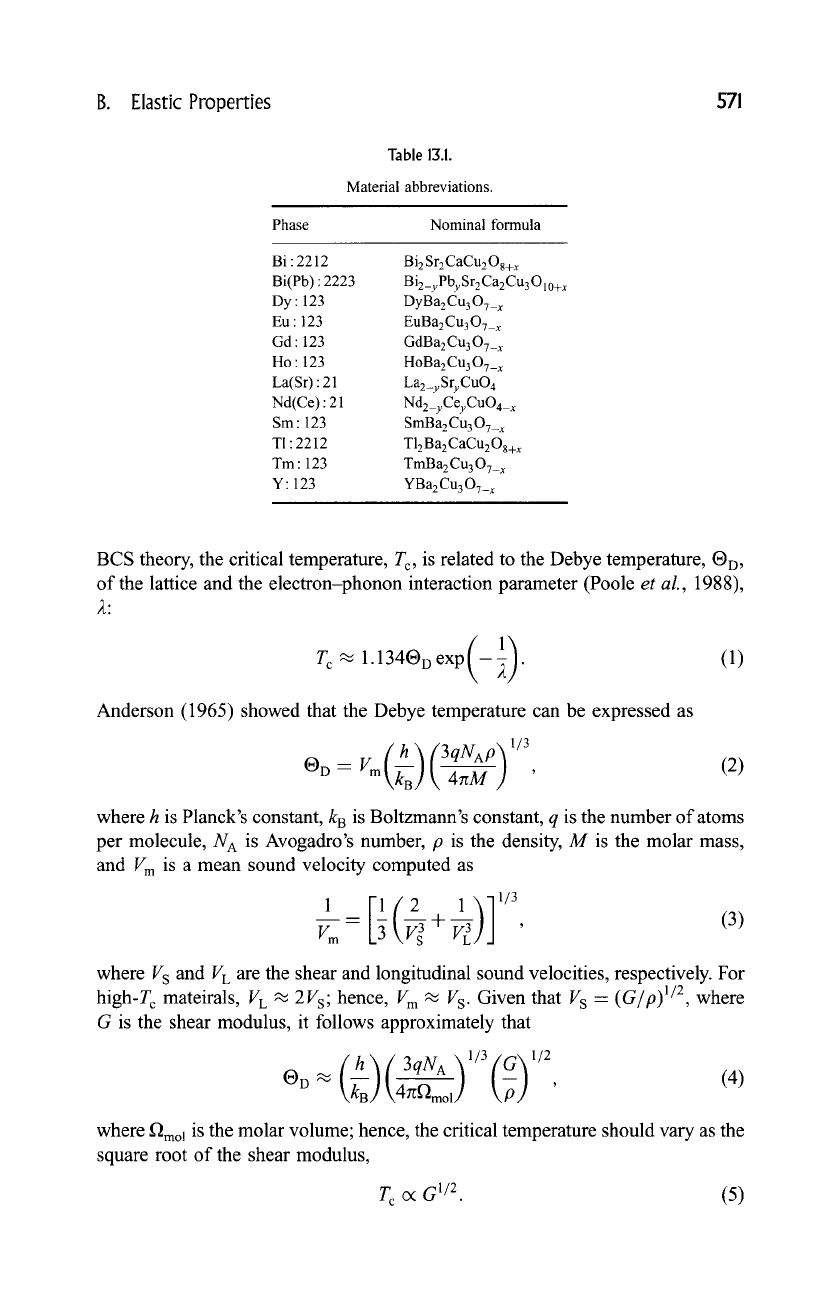
B. Elastic Properties 571
Table 13.1.
Material abbreviations.
Phase Nominal formula
Bi : 2212 Bi 2 Sr2CaCu208+ x
Bi(Pb) :2223
Bi2_yPbySr2Ca2Cu3Olo+x
Dy: 123 DyBazCu307_ x
Eu : 123 EuBa 2 Cu 3 O7_ x
Gd : 123 GdBazCu 3 O7_ x
Ho: 123 HoBazCu307_ x
La(Sr) : 21 Laz_ySryCuO 4
Nd(Ce) : 21
Nd2_yCeyCuO4_ x
Sm: 123 SmBa2Cu3 O7_ x
T1 : 2212 T12Ba2CaCu208+ x
Tm : 123 TmBa 2Cu 3 O7_ x
Y: 123 YBa2 Cu3 O7_ x
BCS theory, the critical temperature, T c, is
related to the
Debye temperature, |
of the lattice and the electron-phonon interaction parameter (Poole
et al.,
1988),
2:
Tc ~ 1.134| D exp (- ~). (1)
Anderson (1965) showed that the Debye temperature can be expressed as
(h)(3qNAP'] 1/3
OD-
Vm kBB ~,
4~tM ] ' (2)
where h is Planck's constant, k B is Boltzmann's constant, q is the number of atoms
per molecule, ]71 is Avogadro's number, p is the density, M is the molar mass,
and Vm is a mean sound velocity computed as
Vm -- + ' (3)
where V s
and
V c are the shear
and longitudinal sound velocities, respectively. For
high-T c mateirals, V L ~ 2Vs; hence, V m ~ V s. Given that V s -
(G/p) 1/2,
where
G is the shear modulus, it follows approximately that
(h)( 3qN A
)1/3 (G)1/2
OD ~ kBB ~,47Zf~mol,] '
(4)
where f~mol is the molar volume;
hence, the
critical temperature should vary as
the
square root of the shear modulus,
Tc oc G 1/2.
(5)
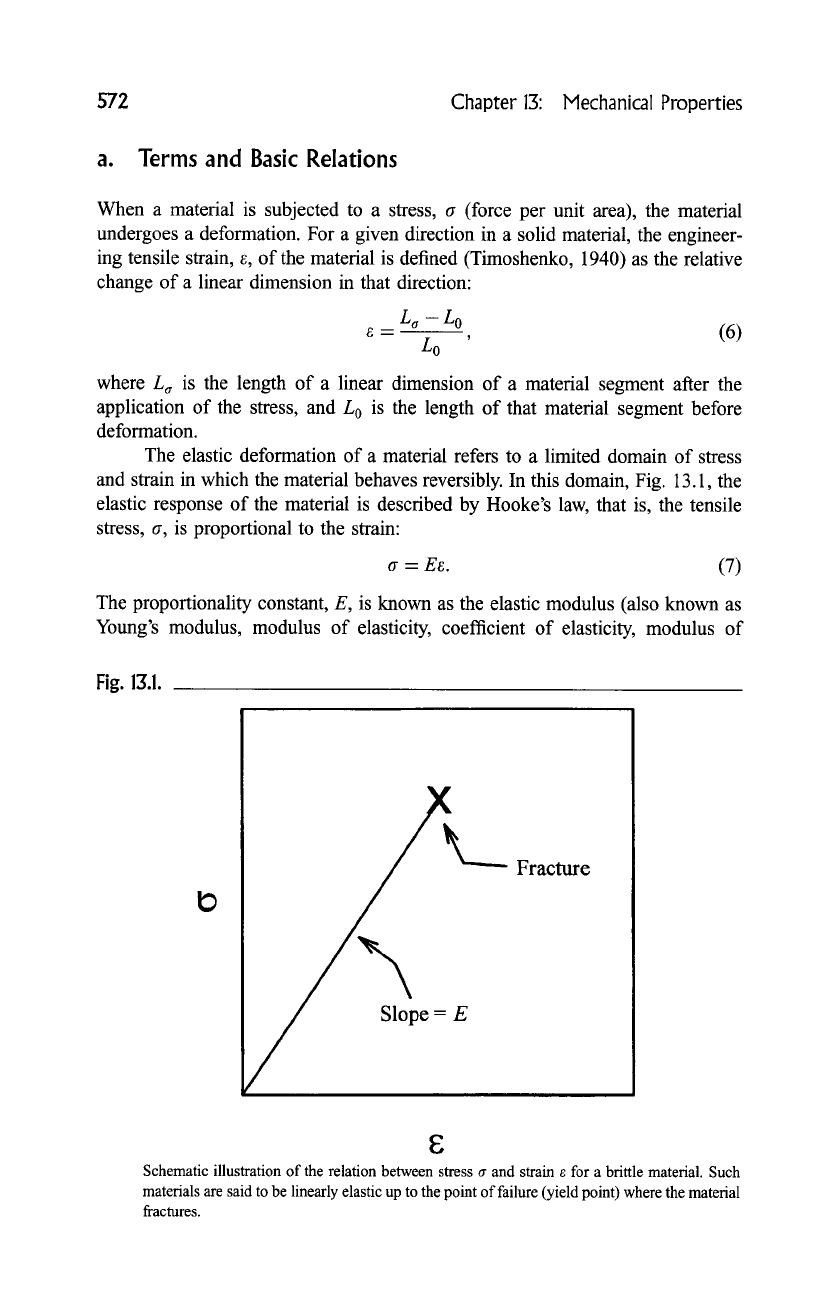
572
Chapter
13:
Hechanical Properties
a. Terms and Basic Relations
When a material is subjected to a stress, a (force per unit area), the material
undergoes a deformation. For a given direction in a solid material, the engineer-
ing tensile strain, e, of the material is defined (Timoshenko, 1940) as the relative
change of a linear dimension in that direction:
L,~ - L o
e - L0 (6)
where Lo is the length of a linear dimension of a material segment after the
application of the stress, and L 0 is the length of that material segment before
deformation.
The elastic deformation of a material refers to a limited domain of stress
and strain in which the material behaves reversibly. In this domain, Fig. 13.1, the
elastic response of the material is described by Hooke's law, that is, the tensile
stress, a, is proportional to the strain:
o- = Ee. (7)
The proportionality constant, E, is known as the elastic modulus (also known as
Young's modulus, modulus of elasticity, coefficient of elasticity, modulus of
Fig. 13.1.
,~ ~ Fracture
E
Schematic illustration of the relation between stress a and strain e for a brittle material. Such
materials are said to be linearly elastic up to the point of failure (yield point) where the material
fractures.
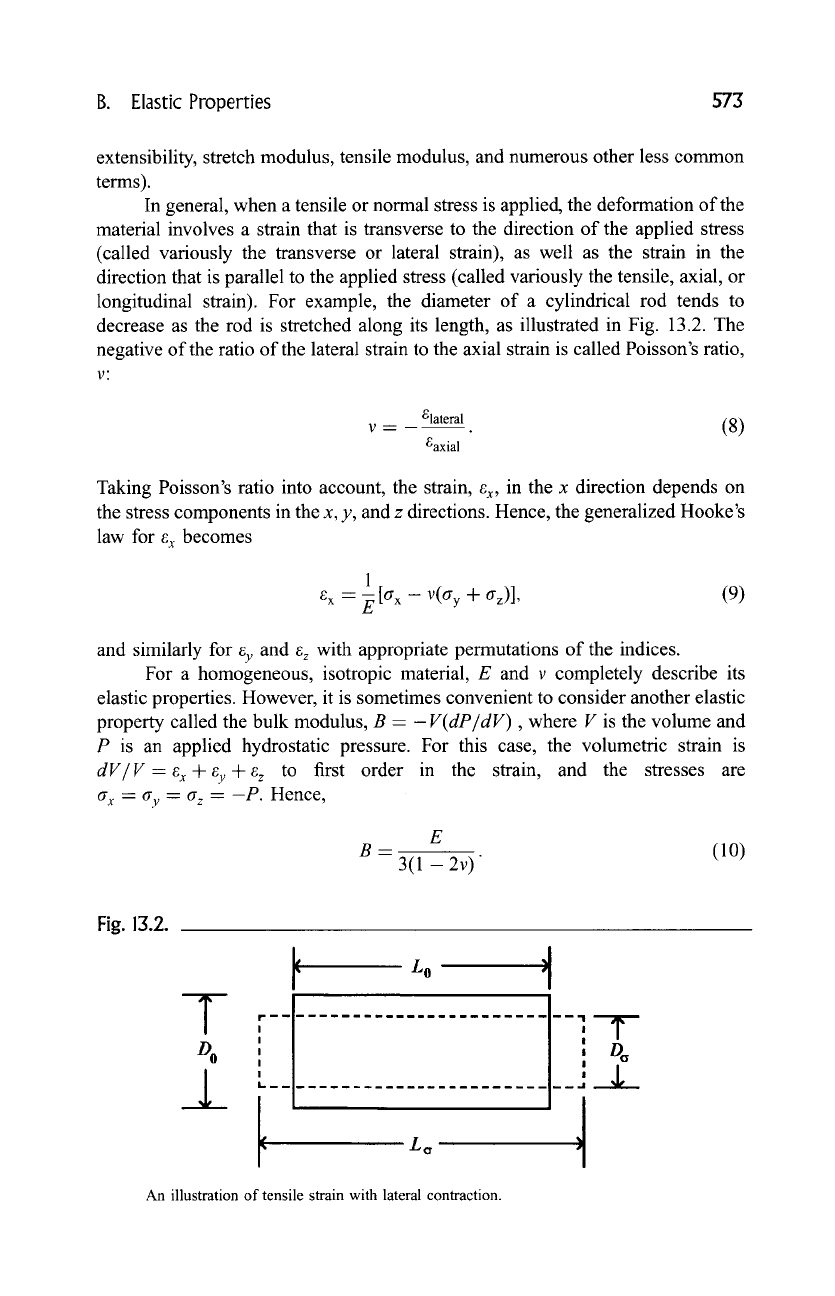
B. Elastic Properties 573
extensibility, stretch modulus, tensile modulus, and numerous other less common
terms).
In general, when a tensile or normal stress is applied, the deformation of the
material involves a strain that is transverse to the direction of the applied stress
(called variously the transverse or lateral strain), as well as the strain in the
direction that is parallel to the applied stress (called variously the tensile, axial, or
longitudinal strain). For example, the diameter of a cylindrical rod tends to
decrease as the rod is stretched along its length, as illustrated in Fig. 13.2. The
negative of the ratio of the lateral strain to the axial strain is called Poisson's ratio,
v:
V -- -- elatera-------~l. (8)
~axial
Taking Poisson's ratio into account, the strain,
e x,
in the x direction depends on
the stress components in the x, y, and z directions. Hence, the generalized Hooke's
law for ex becomes
1
~x -- 2 [O'x -- 1;(O'y + O'z)], (9)
and similarly for
ey
and
ez
with appropriate permutations of the indices.
For a homogeneous, isotropic material, E and v completely describe its
elastic properties. However, it is sometimes convenient to consider another elastic
property called the bulk modulus, B = -V(dP/dV), where V is the volume and
P is an applied hydrostatic pressure. For this case, the volumetric strain is
dV/V =e x
-+-g,y-'~-g'z
to first order in the strain, and the stresses are
ax = ay = az = -P.
Hence,
E
B -- . (10)
3(1 - 2v)
Fig.
13.2.
Y
D.
l
L, Lo ;
r
', ,
' ' ,L
L ,,,I
1
4
An illustration of tensile strain with lateral contraction.
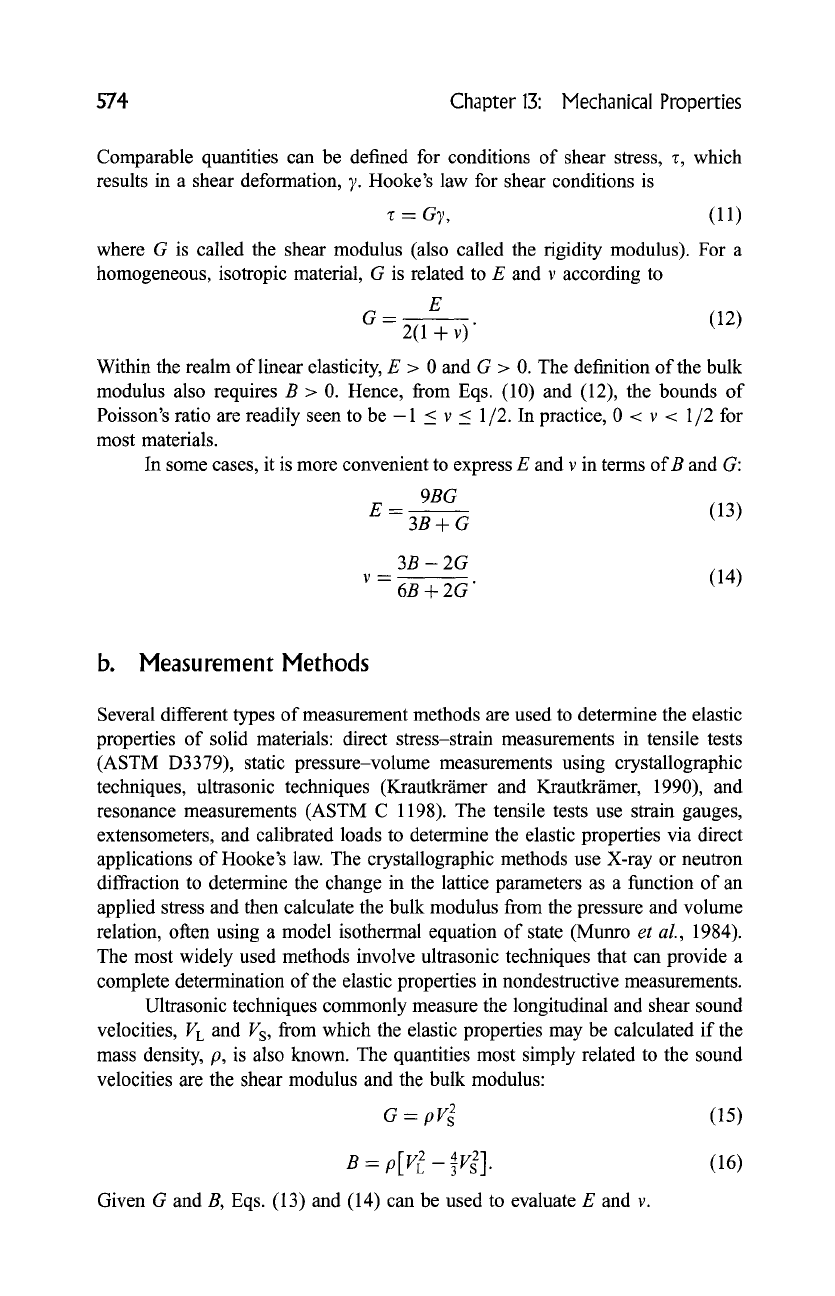
574
Chapter
13:
Mechanical Properties
Comparable quantities can be defined for conditions of shear stress, z, which
results in a shear deformation, 7. Hooke's law for shear conditions is
"v -- GT, (11)
where G is called the shear modulus (also called the rigidity modulus). For a
homogeneous, isotropic material, G is related to E and v according to
E
G - 2(1 + v)" (12)
Within the realm of linear elasticity, E > 0 and G > 0. The definition of the bulk
modulus also requires B > 0. Hence, from Eqs. (10) and (12), the bounds of
Poisson's ratio are readily seen to be -1 _< v < 1/2. In practice, 0 < v < 1/2 for
most materials.
In some cases, it is more convenient to express E and v in terms of B and G:
9BG
E - ~ (13)
3B+G
3B-2G
v -- ~. (14)
6B + 2G
b. Measurement Methods
Several different types of measurement methods are used to determine the elastic
properties of solid materials: direct stress-strain measurements in tensile tests
(ASTM D3379), static pressure-volume measurements using crystallographic
techniques, ultrasonic techniques (Krautkr~imer and Krautkr~imer, 1990), and
resonance measurements (ASTM C 1198). The tensile tests use strain gauges,
extensometers, and calibrated loads to determine the elastic properties via direct
applications of Hooke's law. The crystallographic methods use X-ray or neutron
diffraction to determine the change in the lattice parameters as a function of an
applied stress and then calculate the bulk modulus from the pressure and volume
relation, often using a model isothermal equation of state (Munro
et aL,
1984).
The most widely used methods involve ultrasonic techniques that can provide a
complete determination of the elastic properties in nondestructive measurements.
Ultrasonic techniques commonly measure the longitudinal and shear sound
velocities, V L and V s, from which the elastic properties may be calculated if the
mass density, p, is also known. The quantities most simply related to the sound
velocities are the shear modulus and the bulk modulus:
c-
(15)
B-p[v 4
- gV~]. (16)
Given G and B, Eqs. (13) and (14) can be used to evaluate E and v.

B.
Elastic Properties
575
c. Corrections for Porosity
Porosity in the range of 15 to 40% is quite common for ceramic superconductors.
A considerable effort has been made in the literature to normalize the measured
results to the limiting condition of zero porosity. Both empirical models and
computations based on elasticity theory have been used. The empirical methods
generally are extrapolations based on trend analyses and least squares fitting
techniques. Early investigations suggested that the elastic and shear moduli of
ceramics decreased exponentially with increasing porosity (Spriggs and Brissette,
1962),
Y = Xo e-axp ,
(17)
where X is either E or G; X 0 is the modulus at zero porosity; p = 1
-
P/Pmax
is
the volume fraction of porosity for a material whose density, p, is less than the
theoretical maximum density, Pmax; and
ax
is an empirical fitting parameter.
When comparable trends are found for the elastic and shear moduli, it follows
from Eqs. (12) and (17) that Poisson's ratio should vary approximately linearly
with the porosity,
v = v 0 - r/p; (18)
where r/~ (1 + Vo)(a E -aG).
Other studies have reported linear (Hasselman and Fulrath, 1964),
X = X o - bxp,
(19)
and power-law results (Ishani and Cohen, 1967; Wagh
et al.,
1993),
X -- Yo(1 _p2/3)
(20)
X = X0(1
-p)q,
(21)
where
bx
and q are fitting parameters.
Applications of elasticity theory have generally assumed spherical voids or
inclusions dispersed in an otherwise homogeneous, isotropic medium. Differ-
ences among the various models have resulted from the specific approximations
that are invoked to obtain useful solutions. Mackenzie (1950) applied elasticity
theory to a spherical void surrounded by a spherical shell of matrix material that
was, in turn, surrounded by a self-consistent bulk medium representing the
macroscopic ensemble of matrix material and voids; estimates for the bulk
modulus and the shear modulus were found in the forms
1 1
3p
= B0(1 _ p) + 4G0( 1 _ p) (22)
G o - G (3B 0 + 4G0)
Go = 5p (9Bo + 8Go), (23)
in which higher order terms in p were neglected.
